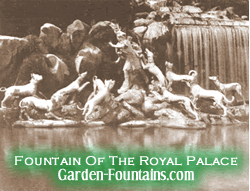 The creation of water fountains can be traced clear back to the ancient Grecian cultures. Water springs were enshrined and adorned with architectural beauty, creating temples dedicated to their Parthenon of gods and goddesses. Brief mentions were made of these elaborate structures, giving us clues to the beauty of these early fountains. A wonderful example comes from a description of the Spring of Pirene at Corinth, which was the city of fountains and was surrounded by white stone where water flowed from outlets into an open basin. A spring, located near the statue of Bellerophon water sprung from the feet of the horse with wings, Pegasus. Another Corinthian fountain was a tribute to Neptune standing on a dolphin where water flows from the dolphin’s mouth. Fountains such as these also included the fountain built by Theagenes located at Megara was magnitude in size and included many decorations. A fountain also stood at Lerna and was encompassed by pillars in an enclosure that included many seats that created a place to relax in the hot summer months. Descriptions of fountains all over Greece demonstrate their vast understanding of the importance and necessity of water to man. The connection between water and man stood in the consistency, cleanliness, and multitude of fountains throughout the cities. It is also known that the fountain at Patrae was surrounded by steps and water flowed from nine pipes from the fountain of Ennea-krounos at Athens.
The creation of water fountains can be traced clear back to the ancient Grecian cultures. Water springs were enshrined and adorned with architectural beauty, creating temples dedicated to their Parthenon of gods and goddesses. Brief mentions were made of these elaborate structures, giving us clues to the beauty of these early fountains. A wonderful example comes from a description of the Spring of Pirene at Corinth, which was the city of fountains and was surrounded by white stone where water flowed from outlets into an open basin. A spring, located near the statue of Bellerophon water sprung from the feet of the horse with wings, Pegasus. Another Corinthian fountain was a tribute to Neptune standing on a dolphin where water flows from the dolphin’s mouth. Fountains such as these also included the fountain built by Theagenes located at Megara was magnitude in size and included many decorations. A fountain also stood at Lerna and was encompassed by pillars in an enclosure that included many seats that created a place to relax in the hot summer months. Descriptions of fountains all over Greece demonstrate their vast understanding of the importance and necessity of water to man. The connection between water and man stood in the consistency, cleanliness, and multitude of fountains throughout the cities. It is also known that the fountain at Patrae was surrounded by steps and water flowed from nine pipes from the fountain of Ennea-krounos at Athens.
 The status of fountains grew; the idea of having a fountain in your city is what actually allowed you to have the status of “city”. The Roman’s took the art and practical uses of fountains to a new level, creating aqueducts to carry water all over the capitol and to major cities, the remains of these aqueducts can still be seen today. They conducted tests on how to distribute water as well as investigated the medicinal purposes of different water springs.
The status of fountains grew; the idea of having a fountain in your city is what actually allowed you to have the status of “city”. The Roman’s took the art and practical uses of fountains to a new level, creating aqueducts to carry water all over the capitol and to major cities, the remains of these aqueducts can still be seen today. They conducted tests on how to distribute water as well as investigated the medicinal purposes of different water springs.
